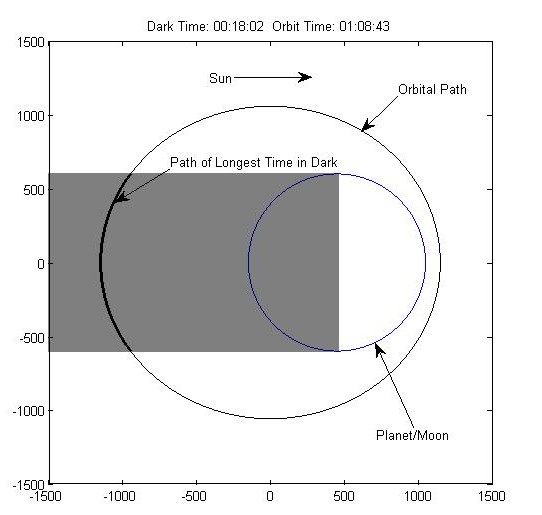Orbit darkness time
This page will give an expression for the worst-case scenario of how long a craft will be in darkness during an orbit. This information can be used to determine how many batteries are needed for a craft to remain powered during the dark portion of orbit.
Contents
Result
Here is the result for calculating the longest amount of time spent in darkness (in units of seconds):
where is the semi-major axis, the semi-minor axis, the specific angular momentum, the eccentricity, and the radius of the planet/moon. For reference, here is how to calculate these terms knowing the Apoapsis (Ap), Periapsis (Pe) and body to orbit:
where you need to provide the following parameters:
: planned Apoapsis of planet the craft will orbit [km]
: planned Periapsis of planet the craft will orbit [km]
: radius of planet to orbit [km] (see wiki page on planet for data, ex: Kerbin)
: gravitational parameter of planet to orbit [km3/s2] (see wiki page on planet for data, ex: Kerbin)
Example: Kerbin has equatorial radius 600 000 m or 600 km. Its gravitational parameter is 3.5316000×1012 m3/s2 or 3.5316000×103 km3/s2.
Limitations
This method assumes the orbit is stable and elliptic. It also assumes the sun's rays are parallel across the orbiting planet. The method gives the longest amount of time spent in darkness, which for polar orbits, will only be experienced periodically. However, it is a good idea to plan on the worst-case amount of time in darkness. Lastly, the method does not take into account darkness caused by a different body than the orbited body (i.e. if you are orbiting Laythe and Jool blocks the sun, this method does not account for that).
Application
By entering the equations into a program such as Microsoft Excel, the darkness time can be calculated for various orbits around any planet or moon. Knowing the amount of time spent in darkness and the energy drain, the battery storage can be calculated by
where is the battery storage required in the electricity unit e, is the rate of energy use in units of e/sec, and is the darkness time in seconds.
The darkness time can also be used to calculate how many solar panels are needed to recharge the batteries before the next cycle of darkness. However, the time spent in sunlight is quite long, and typical recharge rates are much smaller than the power provided by even a single solar panel.
Examples
Orbiting Kerbin with 100 km Circular Orbit
Using 0.05 e/s for the RC-001S and 0.04 e/s for the Illuminator Mk1 for a total drain of 0.09 e/s:
So at least 57.8 e of electricity is needed in storage to make it through the darkness for this orbit around Kerbin, using 0.09 e per second. The battery with the next largest amount of storage (as of 0.21) is the Z-100 with 100 e of storage.
Orbiting Jool with Apoapsis 700 km and Periapsis 200 km
Using 0.05 e/s for the RC-001S and 0.16 e/s for 4x Illuminator Mk1 for a total drain of 0.21 e/s:
So at least 505 e of electricity is needed in storage to make it through the darkness for this orbit around Jool, using 0.21 e per second.
Darkness times for planets and moons
The following table contain the darkness times for the planets and moons. The orbit is circular and has an altitude of 20% of the body's radius.
























